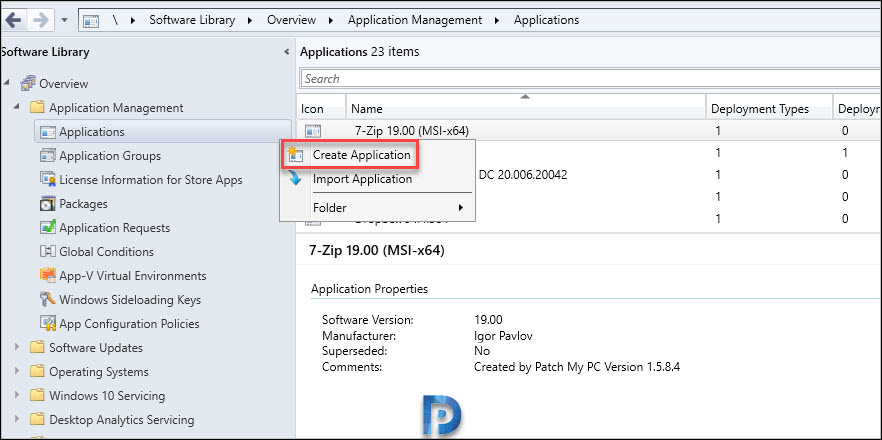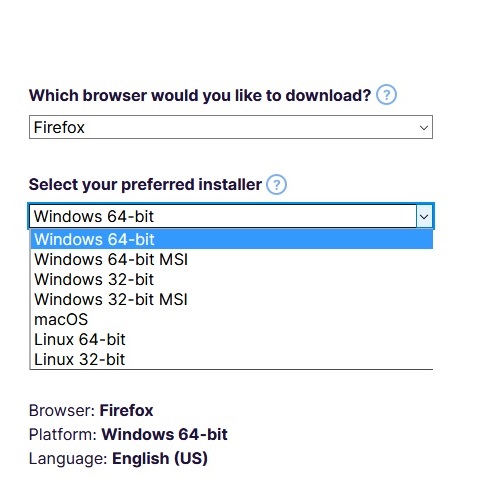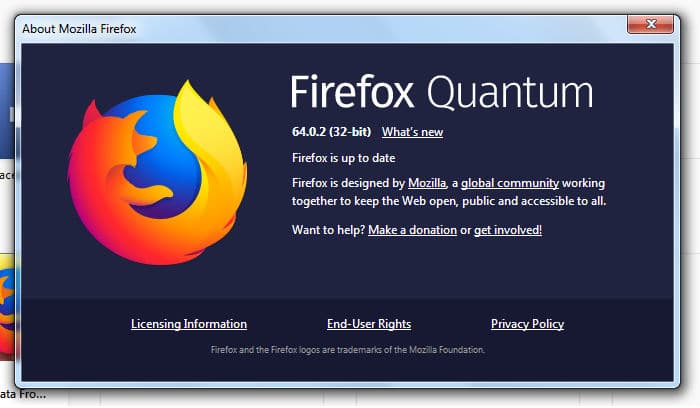Firefox Msi Installer
The full installer provides a number of options that can be used either from the GUI or from the command line. The following command line options are accepted. The list is valid for Firefox 62 and later. Firefox Enterprise offers MSI installers per locale, per cpu architecture (32 and 64 bit) and per channel to help system administrators customize and deploy Firefox in their environments. The MSI installer is free to download and use. If you are a home user, please do not use our installer. Instead download from the official Mozilla Firefox site. For Group Policy support, use FrontMotion Firefox Community Edition. To deploy with extensions, use the Firefox Packaging Service. While Mozilla Firefox MSI behaves like the EXE installer, and creates a registry path for uninstall like so: HKEYLOCALMACHINE SOFTWARE Microsoft Windows CurrentVersion Uninstall Mozilla Firefox 67.0.4 (x64 en-US) And thus, Intune is not able to verify wether Firefox was installed.
How to build the installers¶
The easiest way to build an installer in your local tree is to run machpackage. The finished installers will be in $OBJDIR/dist/install/sea/. You have to have a build of the application already done before that will work, but artifact builds are supported, so that can save you a lot of time if you’re only doing installer work.
You’ll also need to be on a Windows machine; the installer build depends on tools that aren’t available for other platforms.
Stub installer¶
The stub installer probably won’t be built by default in a local tree; normally unless the build has been set to use one of the official update channels, only the full installer is built. Download tube for mac. If you need to work on the stub installer, you can override the default and get one built along with the full installer by adding exportMOZ_STUB_INSTALLER=1 to your mozconfig.
Uninstaller¶
The uninstaller is built as part of the main application build, not the installer target, so machbuild is what will get you an uninstaller. You’ll find it at $OBJDIR/dist/bin/uninstaller/helper.exe.
Linux Msi Installer
Branding¶
By default local builds use “unofficial” branding, which somewhat resembles a previous version of the Nightly branding, but is designed not to resemble any official channel too closely.
But sometimes you’ll need to test installers that are built using one or more of the official channel branding configurations, perhaps to try out different strings, make sure different sets of art look good, or to test behavior around installing multiple channels at the same time.
You can build installers (and the entire application) with official branding by adding ac_add_options--with-branding=browser/branding/{nightly|aurora|official} to your mozconfig (the default branding is browser/branding/unofficial).
Build process¶
Note

If you intend to distribute your build to others, you’ll want to addexportWIN32_REDIST_DIR=<CRT_LOCATION> in your mozconfig. The CRT locationwill vary depending on your Visual Studio version. At the time of writing, this would look like:exportWIN32_REDIST_DIR='/c/ProgramFiles(x86)/MicrosoftVisualStudio/2019/Community/VC/Redist/MSVC/14.28.29325/x86/Microsoft.VC142.CRT'.
Both the full and stub installers are built through a similar process, which is summarized here along with references to the relevant bits of code.
Most of this procedure is done in makensis.mk and in the mach repackage command.
A prerequisite is for the application to be in a packaged state, so
machpackagefirst creates a release-style package and puts it in$OBJDIR/dist/firefox.All required files are copied into the instgen directory. This includes .nsi and .nsh script files, plugin DLL files, image and icon files, and the 7-zip SFX module and its configuration files.
The NSIS scripts are compiled, resulting in setup.exe and setup-stub.exe (if building the stub is enabled).
The 7-zip SFX module is run through UPX.
The application files and the full installer setup.exe are compressed together into one 7-zip file.
The stub installer is compressed into its own 7-zip file.
The (UPX-packed) 7-zip SFX module, the correct configuration data, and the 7-zip file containing the application files and setup.exe are concatenated together. This results in the final full installer.
The (still UPX-packed) 7-zip SFX module, the correct configuration data, and the 7-zip file containing the stub installer are concatenated together. This results in the final stub installer.
If this is an official build running on Mozilla automation infrastructure, then after this the installers will be signed, like other build products. Release engineering owns that process, it’s not within the scope of this documentation.
Firefox Enterprise offers MSI installers per locale, per cpu architecture (32 and 64 bit) and per channel to help system administrators customize and deploy Firefox in their environments.The MSI installer (supported on Windows 7 and later versions) is a wrapper of the exe full installer that allows customizations through the use of a MST file prior to deploying through standard Windows deployment tools such as Active Directory or Microsoft System Center Configuration Manager.
Table of Contents
- 2Configuration options
- 3MSIEXEC options
- 4Example configuration

Visit https://www.mozilla.org/firefox/all/ and use the drop-down options to select a MSI installer for Firefox Nightly, Developer Edition, Firefox Beta, Firefox Release or Firefox Extended Support Release.
MSI transforms (MSTs) for the Firefox MSI installers can be created or edited using the tool of your choice (MS Orca or other) to customize the installation. This section details the options available.
Firefox custom MSI options
Set a directory path - INSTALL_DIRECTORY_PATH=[path]Absolute path specifying the complete install location. This directory does not need to exist already (but it can).If INSTALL_DIRECTORY_NAME is set, then this setting will be ignored.
Set a directory name - INSTALL_DIRECTORY_NAME=[name]Name of the installation directory to create within Program Files. For example, if INSTALL_DIRECTORY_NAME is set to Firefox Release, then the installation path will be something like C:Program FilesFirefox Release. The Program Files path used will be the correct one for the architecture of the application being installed and the locale/configuration of the machine; this setting is mainly useful to keep you from having to worry about those differences.If this is set, then INSTALL_DIRECTORY_PATH will be ignored.
Install a taskbar shortcut - TASKBAR_SHORTCUT={true,false}Set to false to disable pinning a shortcut to the taskbar. true by default. This feature only works on Windows 7 and 8; it isn’t possible to create taskbar pins from the installer on later Windows versions.
Install a desktop shortcut - DESKTOP_SHORTCUT={true,false}Set to false to disable creating a shortcut on the desktop. true by default.
Install a start menu shortcut - START_MENU_SHORTCUT={true,false}Set to false to disable creating a Start menu shortcut. true by default.
Disable the maintenance service - INSTALL_MAINTENANCE_SERVICE={true,false}Set to false to disable installing the Mozilla Maintenance Service. This will effectively prevent users from installing Firefox updates if they do not have write permissions to the installation directory. true by default.

Disable removing distribution directory - REMOVE_DISTRIBUTION_DIR={true,false}Set to false to disable removing the distribution directory from an existing installation that’s being paved over. By default this is true and the directory is removed.
Prevent rebooting - PREVENT_REBOOT_REQUIRED={true,false}Set to true to keep the installer from taking actions that would require rebooting the machine to complete, normally because files are in use. This should not be needed under normal circumstances unless you’re paving over a copy of Firefox that was running while the installer was trying to run, and setting this option in that case may result in an incomplete installation. false by default.
Bundle extensions - OPTIONAL_EXTENSIONS={true,false}Set to false to disable installing any bundled extensions that are present. true by default. Adobe 2017 for mac.
Application files extraction directory - EXTRACT_DIR=[directory]Extract the application files to the given directory and exit without actually running the installer. Of course, this means all other options will be ignored.
The command line parameters for msiexec.exe (the Windows component responsible for installing, uninstalling, and otherwise working with MSI files) are documented here and also by the output of the /? option. Our MSI packages, because they wrap a .exe installer and don't really use the MSI framework, do not support many of the command line parameters available to msiexec. This document lists the msiexec parameters that are supported and unsupported for use with our MSI packages.
 Download the BitPay App to securely send, receive and store cryptocurrency. Buy and exchange crypto all in one app.
Download the BitPay App to securely send, receive and store cryptocurrency. Buy and exchange crypto all in one app.
Supported MSIEXEC Options
- /i or /package
- Installs the product.
- /L or /log
- Generates an MSI log file. All of this option's configuration parameters are supported.
- /m
- Generates an SMS status .mif file.
- Without having a copy of Systems Management Server I've been unable to test this, but it should work.
- /q, /quiet, and /passive
- Sets the UI mode. The full UI option (/qf) is accepted but ignored, because we have no full UI.
- /norestart, /forcerestart, and /promptrestart
- The default behavior is always /norestart, but the other options behave as expected.
- PROPERTY=VALUE
- Command line property configuration is supported for all public properties we provide (meaning the ones with UPPERCASE_NAMES).
Options that do not operate on a package file (/?, /h, /help, /y, /z)
Unsupported MSIEXEC Options
- /f
- Repairs the product.
- /a
- Administrative installation.
- /x or /uninstall
- Uninstalls the product.
- /j along with /t, /g, and /c
- Advertises the product.
- /n
- Specifies a particular instance of the product.
- /p or /update
- Applies a patch (.msp) file.
Here’s an example of a valid .mst file to help understand how options can be changed along with the MSI directory for mozilla central:
There are several ways to use the MSI file with configurable parameters exposed in Firefox MSI:
By using an external MSI editor (e.g. ORCA)

- File/Open and select the MSI to be edited.
- Find the Property table and select it.
- Change the values for the PROPERTIES you need to.
- From ORCA, select File/Save as and save the custom modified MSI installer.
By using a transform (.mst) configuration
- Use Orca to open the MSI.
- Select Transform > New Transform from the menu bar.
- Change the values for the PROPERTIES you need to.
- Select Transform > Generate Transform to save your changes as a transform (.mst) file.
- Run: msiexec /i “Firefox.msi” TRANSFORMS=”custom.mst”
By using command line parameters

Download Mozilla Firefox For Windows 10 2017
- Rename the Firefox MSI file as default.msi
- Move the file in a C:MSI directory
- Run:
- msiexec.exe /i 'c:MSidefault.msi' INSTALL_DIRECTORY_PATH='C:Firefox' TASKBAR_SHORTCUT=false DESKTOP_SHORTCUT=false INSTALL_MAINTENANCE_SERVICE=false /quiet
